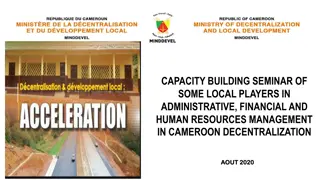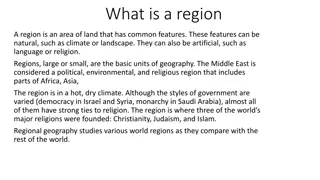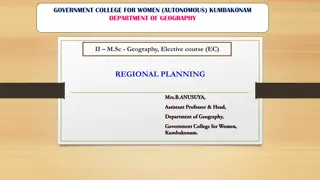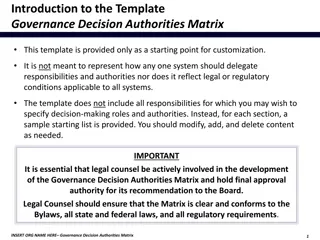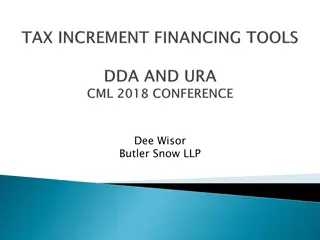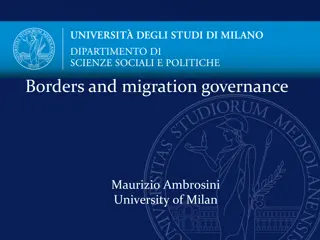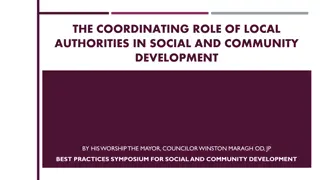EU Governance Elements: Regions and Local Authorities
This content covers various EU governance elements such as the role of regions and local authorities, cooperation, and partnership in providing sustainable solutions. It includes insights from documents like the CPMR Vision, EU Commission's scenarios White Paper, and the European Council's Rome Declaration. The importance of transparency, citizen involvement, and trust in local and regional politicians is highlighted. People's demand for more EU action in areas like freedom and prosperity is also discussed.
Download Presentation

Please find below an Image/Link to download the presentation.
The content on the website is provided AS IS for your information and personal use only. It may not be sold, licensed, or shared on other websites without obtaining consent from the author.If you encounter any issues during the download, it is possible that the publisher has removed the file from their server.
You are allowed to download the files provided on this website for personal or commercial use, subject to the condition that they are used lawfully. All files are the property of their respective owners.
The content on the website is provided AS IS for your information and personal use only. It may not be sold, licensed, or shared on other websites without obtaining consent from the author.
E N D
Presentation Transcript
DimitriosV. Skiadas, MJur, PhD Professor of European Governance Dept. of International and European Studies University of Macedonia
CPMR Vision Approved by the CPMR General Assembly, 19-20 October 2017, Helsinki (Finland) The EU Governanceelements of theVision: Regions and local authorities are at the core, and recognised as (i) an essential bridge between citizens and the EU Institutions, and (ii) key to providing sustainable solutions to the many challenges facing Europe; Co-operation and partnership is reinforced and strengthened, validating the role played by regions and local authorities in animating this. Coherence, coordination and cooperation between all levels of governments should be at the core of any vision of Europe;
EU Commissions scenarios White Paper on the Future of Europe 1 March 2017 1. Carrying On: The EU27 focuses on delivering its positive reformagenda 2. Nothing butthe Single Market: The EU27 is gradually re-centred on the single market 3. ThoseWhoWant More Do More: The EU27 allowswilling Member States todo more togetherin specific areas 4. Doing Less More Efficiently: The EU27 focuses on delivering more and faster in selected policy areas, while doing less elsewhere 5. Doing Much MoreTogether: Member Statesdecide todo much more togetheracross all policy areas
European Council - The Rome Declaration 25 March 2017 The EU Governanceelements of the Declaration: We will act together, at different paces and intensity where necessary, while moving in the same direction, as we have done in the past, in line with the Treaties and keeping the door open to those who want to join later. We will work together at the level that makes a real difference, be it the European Union, national, regional, or local, and in a spirit of trust and loyal cooperation, both among Members States and between them and the EU institutions, in line with the principle of subsidiarity. Thus, the EU leaders haveopted forscenario 3.
Committee of Regions Reflecting on Europe 10.4.2018 Findingsof survey: People are enthusiastic about the EU but they also feel disconnected, distant and disappointed from EU politics and institutions at the same time, a feeling that does not onlyconcern theirperception of the EU but politics in general. People trust their local and regional politicians more than they trust EU or national politicians. In many dialogues with citizens, these levels have been presented together and it has often been the combination of local, national and EU politics, which made it possible to present the different levels of responsibility in a coherentway. People demand higher levels of transparency and ownership and more active ways to become involved while they confirm at the same time a lack of knowledge about the EU and how it works. In terms of policy fields, people ask for more EU action with regard to freedom, prosperity, mobility, solidarity, education, environment, securityand tourism. Overall: Compared to the EU, Europe still has a positive image for most people, in particular when it comes to the values and benefits that the young generation associateswith it.
CPMR Standards for Regions in EU Governance Regions are not just another stakeholder to be grouped along with business, sectoral representations and lobbying organisations. Regions, as elected bodies, are essential in addressing the democratic deficit in the EU, acting as the agents through which EU policy is implemented on the ground, delivering EU programmes and projects, and providing a direct link between Brussels and citizens. The current institutional structures within the EU are inadequate to represent the formal status of regional authorities. The role of the Committee of the Regions as an advisory body in the EU decision-making process must be strengthened, particularly within the ordinary legislative procedure where its opinions are not binding. The engagement of European Parliament with regional governments and parliaments should be strengthened. Co-operation and partnership are at the core of what the EU stands for, bringing people together, helping to cross political and cultural boundaries, as well as facilitating economic exchange. Thus co-operation brings a clear added value, enabling mutual learning and joint working to solve problems and develop new ways of working and living. It helps to overcome fragmentation, and provides a long-term framework for co-ordinated action. Regions play a central role in driving such co-operation through animating links between partners from all sectors and levels, be this through smart specialisation networks, renewable energy projects, training, education, research, migration, health, external development and a host of otherpolicy areas.
Reflections and considerations In order to assess the Regions and Local Authorities role in the structures and operation of EU governance, one should locate areas where in the Regions treatment by the EU is indicative of the relevant perceptions adopted in the EU context. Three such areasarequite indicative: The Regions and Local Authorities involvement in thecontext of subsidiarity The Regions and Local Authorities participation in EU decision-making The Regions and Local Authorities possibility of accessing judicial protection in the EU. The conceptual framework of EU Governance creates some real challenges for the regional and local authorities of the Member States. More specifically, the EU operates according to competences conferred upon it by the Member States (including competences which at national level belong to sub-national authorities). These competences are carried out by the Union s own institutions which reflect its dual nature as a supranational (European Commission, European Parliament) and intergovernmental entity (Council). Thus, the EU decision making process has been dominated by the central governments of the Member States, represented in the Council by their ministers, even when issues on the Council s agenda were not within the scope of thecentral governments but within thatof sub-national entities. Furthermore, the mere transfer of state powers to the EU level, when including competences which at national level belong to sub-national authorities , creates a real paradox: As such powers have been transferred to the supranational level, a significant proportion of the competences reserved for sub-national entities by the national constitution is ultimately exercised in Brussels. This means that they will be exercised by the EU institutions which are controlled, directly or indirectly, by the national central governments.
In addressing these concerns, it has been argued that since the Regions from different Member States have different powers, the main areas of overlap between the powers of the Regions and those of the EU vary from Member State to Member State, ranging from considerable asymmetry among powers granted to the different regions to cases of limited asymmetries. Thus, it is considered somewhat difficult to consider the Regions as an homogeneous level of governance with a clear physiognomy of their own within the EU. Therefore, it has been found equally difficult to establish a specific description for the Regions involvement in the EU governance scheme. This difficulty has been expressed in various instances. With regard to the so called EU shared competences ie fields of policy in which both EU and national legislative and administrative action is allowed, the Union, has to comply with the principle of subsidiarity, which entails taking into account not only the national level but also the sub-national levels of government within the Member States. The national parliaments are entitled to verify that and they use the so called early warning system , provided for in the Protocol on Subsidiarity. More specifically, any national Parliament or any chamber thereof (ever a regional chamber) is entitled, within 8 weeks from the date of transmission to it of a draft EU legislative act, to send to the political institutions a reasoned opinion stating why it considers that the draft in question does not comply with the principle of subsidiarity (early warning). This allows either directly the chambers of the regions (if there are such bodies) or indirectly the regional authorities, through their national parliaments, to communicate with the EU institutions and to play a role in the development of legislation. However, there is no guarantee at all that they will be listened to. And it will be even more difficult for all European regions to agree on a single point of view as their powers and interests vary from Member State to Member State.
With regard to the participation of the Regions in the EU decision-making process, the current arrangement provides for the Committee of Regions, as a body representing the Regions, to give an opinion on the legislative initiatives of the uropean Commission before these are sent to the Council and the Parliament for discussion. The lack of any binding effect with regard to the substance of the opinion (the procedure of seeking such an opinion is binding but with specific timeframes for its delivery) reduces the impact of the Regions involvement. However, another point is interesting. The original EEC provisions, with regard to the participants in the Council were interpreted that such positions were formally linked to the post of member of a national cabinet. However, after the Maastricht Treaty amendments, the relevant provisions were interpreted as allowing the representation of the Member States at ministerial level, as this level is defined in the national context, ie ministers of the national or the regional government, provided only that the representative may legally commit the Member State and cast its vote. This new approach demonstrated that EU law takes into account (some aspects of) the internal organisation of the Member States (especially those with a strong decentralised structure), and allows the Member States to deal internally with the issue of ensuring adequate representation of its constituent authorities in the Council. Thus, there are two different sorts of possibilities for the Member States to organise their representation in the Council: the internal cooperation of central government and regional entities, on the one hand, and the external representation of the regions in the Council, on the other. Both forms can be and areoften used cumulatively.
Internal cooperation means that the national government and the executive powers of the sub-state entities liaise before a meeting of the Council in order to adopt if possible a common position. Three sorts of internal cooperation have identified when Council meetings deal with matters belonging to thecompetence of the Regions. The first ascribes an equal weight to the positions of the national government and of the sub-stategovernments in establishing a common position (ie Belgium). The second allows the sub national entities to play a significant role in reaching a common position at the domestic level, but they are not treated as complete equals of the national government (ie Austria, Germany, Spain). This pattern entails the obligation for the national government to consult the Regions. The position of the Regions resulting from thisconsultation may bind the national government. The third restricts the role of the regional entities in the search towards a common position to the consultation of the Regions by the national government (ie Italy, Greece and UK). The consultation may or may not be obligatory in terms of procedure, but it is not binding in termsof substance.
As for the external representation of the Regions in the Council, again three forms can be indentified: The first is based upon a full representation of the country by one of its Regions in cases where they are competent for the matter which is dealt with by the Council (ie Belgium, Germany). The second entails the potential to permit the Member State to be represented in the Council by a regional official (Minister or Governor). This may happen when the issue on the Council agenda concerns a matter of regional competence or affects vital interests of the Regions (ie Austria). The third is characterised by the fact that the Regions can become a part of the national delegation to the Council. The true and actual weight of such participation is restricted, though, by the indivisibility of the national delegation before the EU (Spain, Italy, Greece), and in a variation of this form (see UK), the role of the Regions in the representation determined by the Minister who takes the overall responsibility for the negotiations and determines how each member of the team can bestcontribute to secure theagreed position.
As for the Regions legal ability to seek judicial protection in the EU (the locus standi issue), the current provision is that only the Committee of Regions is a semi-privileged applicant, ie it can take a case before the EU Courts in order to protect its prerogatives. The Regions themselves are treated as non-privileged applicants , ie they need to have legal personality and be either the addressee of a EU decision or directly and individually concerned by a decision addressed to another person or contested piece of EU legislation. The only alternative open for the regional authorities open is to seek the activation of the national governments, as these are treated as privileged applicants at EU level. This alternative has been employed repeatedly, with three patternsof implementation: The first pattern is based on the right of a single regional authority to oblige the central government to bring a claim for judicial review under Art. 263(2) TFEU (ie Belgium and Austria) The second pattern is based on the right of the majority of the regional authorities to compel the central government to challenge an EU act under Art. 263(2) TFEU (ie Germanyand Italy). The third pattern recognises the right of regional authorities to request the central government to bring a claim against an EU act, without the central government being underany legal obligation todo so (ie Spain, France, Greece).
Conclusions Given the EU s supranational nature, its membership includes and will include for the foreseeable future entities only at the level of state. This has lead to an institutional structure of governance with a limited role for regions and sub- national entities. This Blindness) (see Panara & De Becker, 2011, and the references therein). arrangement has been described as Landesblindheit (Regional The Regions are currently excluded from the hard core of the Union s power, because the focus of the Union is still on economic issues, whereas the Regions main focus (apart from agriculture) is on areas in which the Union has only limited responsibility (e.g. school education, civil protection, tourism and culture). The participation of the Regions in EU governance (law and policy making ) does not depend only on EU law. This participation is also filtered by the Member States, and its scope varies significantly from Member State to Member State. Given that the Member States conferred power, authority and competences to the EU, theywill set the pace for increasing the Regions involvement in EU governance.
The real challenge is to overcome the supranational context and the heterogeneity of the regional level. If a Europe of the Regions is to emerge, more daring initiatives are required. And such initiatives may start from a specific point that may unfold into a majorchange. An Assessment scheme employed for the legislative initiatives in the EU as well as the implementation of the EU Cohesion policy. This reform would call for a departure from the dominant EU view, that such an assessment should be focused in discovering what are the likely economic, social and environmental impacts of a policy, both intended and unintended, as well as potential trade-offs and synergies, and consider it as a tool of a more integrated approach which assesses the impacts of a given project, programme, or policy in the main dimensions of territorial development, which include: (i) economic competitiveness, (ii) social sustainability, (iv) territorial governance, and (v) spatial planning. Such elements can be better served by the regional authorities, their input taking the form, for instance, of a reasoned and binding opinion of the Committee of Regions. This would meet also the CPMR standards named above. Thus the Regions involvement would not be just a concession owed to the national authorities good will buta reply toaverified necessity. interesting example entails reforming the Territorial Impact cohesion, (iii) environmental







